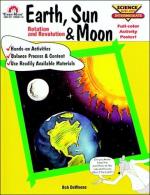|
This section contains 423 words (approx. 2 pages at 300 words per page) |

|
Although often confused, there is a distinct and important difference in the concepts of revolution and rotation. Earth rotates on its axis as it revolves around the Sun.
Earth rotates about its axis at approximately 15 angular degrees per hour. Rotation dictates the length of the diurnal cycle (i.e, the day/night cycle), creates "time zones" with differing local noons, and also causes the apparent movement of the Moon, stars, and planets across the "celestial sphere". The rotation of Earth is eastward (from west to east) making the apparent rotation of the celestial sphere from east to west.
The rates of rotation and revolution are functions of a planet's mass and orbital position. For example, the mass of Jupiter is approximately 317.5 times Earth's mass and the rotation time (the time for Jupiter to revolve once about its axis) is approximately nine hours.
Earth takes...
|
This section contains 423 words (approx. 2 pages at 300 words per page) |

|


